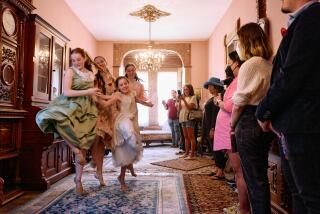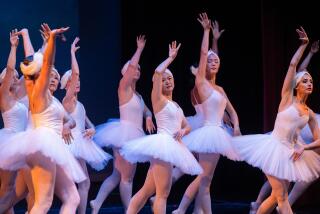Her Women’s Movement
- Share via
“I am constantly aware that I am a woman in a patriarchal society,” begins choreographer Laura Gorenstein Miller, in the artistic statement she sends out as part of the press kit for her six-woman L.A.-based dance troupe, Helios Dance Theater. “What I care about are ways in which I and other women shape our identities in the face of male precedence.”
If her PR material has the somber tone of an honors thesis in gender politics, her work is far less didactic. Critics have called it “powerful, witty and sharp-edged” and “a potent, near-flawless blend of humor and pathos.”
“I really enjoy a roller coaster experience in dance and I think an audience does too,” Gorenstein Miller says one recent afternoon at the Conjunctive Points Dance Center in Culver City, where Helios is rehearsing for a concert this coming weekend at UCLA’s Schoenberg Hall (with another scheduled in May at Cal State Northridge). “It can’t all be this tense dramatic emotional stuff,” she continues. “You need release and humor and satire. It makes everything sink in a lot more.”
She’s dressed in all black, but she’s not exactly a stereotypical feminist poster child, her pedicured toes painted pale metallic blue, long hair bleached bright blond. None of which would matter very much, if she didn’t seem rather self-conscious about it. She wonders aloud if she should have worn her hair up today, “because I’m not going to be taken as seriously with long blond hair.” And when it’s her turn to pose for the photographer, she stares uneasily into the camera, fidgets with the sweater tied around her waist. “Are you getting my whole body?” she asks with open-hearted dread.
Inspired by “observations which disturb or excite” her, Gorenstein Miller, 29, says she looks for choreographic ideas in everyday gestures, combining familiar archetypes of women--from the strut of a runway model to the self-conscious posturing of a girl walking down a street--with classical and modern dance steps to build her social commentaries. The work is as much about narrative and theater as pure dance.
“I’m bored by just plain movement,” she says. “I don’t like to go see dance shows where it’s just about the technique. I need communication. That’s what really moves me. Almost all of my dances come from a very specific emotional place or a narrative place.”
The upcoming show includes one brand-new work, “Red Foxx,” a solo danced atop a 4-foot-tall disco shoe. While the UCLA/Schoenberg Hall performance--Helios’ most high-profile performance to date--is being billed as a night of premieres, the works are actually new versions of previously seen pieces: “Yellow Roses,” about the turmoil of lovers, has been developed from a solo into a duet; “Electric Lilies,” about women trying to succeed in a man’s professional world, has been turned from a solo into a trio. “Sisters,” about the paralysis of dysfunctional families, is being interpreted by two new dancers. And a new section has been added to “Angel’s Domain,” Gorenstein Miller’s four-part work about life in Los Angeles.
Gorenstein Miller says she often has to see her work performed onstage before she realizes that she’s not satisfied with it. “Unfortunately I tend to learn the most in performance,” she says. “So when I’m out in the audience and I’m watching it, that’s when I go, ‘That didn’t work.’ There is just a whole different energy that happens when an audience is with you. That’s where everything comes shining out, whether it’s for the worst or the best.”
Gorenstein Miller says she founded the all-female company because “I’m just totally inspired by women. At the time I felt safest to create around women.”
Does she still feel that way?
“It’s evolved,” she says. When she added a coed duet into “Angel’s Domain,” she says, “I got flak for it from people around me, not from critics, but from people who knew the company: ‘Why would you want to work with a man’ and ‘Why is that necessary?’ Well,” she says matter-of-factly, “my vision has expanded.”
*
Gorenstein Miller wanted to be a choreographer from the age of 4, when she took her first “creative movement” class. “I learned at a very early age that movement is the way I can say the things I want to say,” she says.
She studied modern dance until age 10, then switched to ballet, continuing her studies through college.
“I’m not built like a ballet dancer,” says Gorenstein Miller, who is tall and has a little more meat on her bones than the average dancer.
“I mean, there was just no way that was going to happen,” she says, laughing briefly. Gorenstein Miller moved from Milwaukee to Los Angeles to attend CalArts, where she graduated in 1992 with a degree in dance. She chose the school, she says, because “CalArts is known for not putting any restrictions or bounds on your vision as a young artist.”
After graduation, she danced a bit with local companies Diavolo and Collage Dance Theatre but was frustrated working for other choreographers. “I want to lead,” she says. “I want my own voice to be heard. That’s my personality. I’m not happy doing other people’s movement.”
Her first choreography was done for students at the Orange County High School for the Performing Arts; then in 1995, she founded Helios, initially by going back to her CalArts alumni directory. Everyone involved in the company--from the dancers to the graphic artist who helped put together the press kit--were former classmates. Even her husband of two years, Chris Miller, a DreamWorks animator and video artist, is a CalArts alum--he contributes to the Helios effort by building sets and creating slide shows and animation for the performances.
Founding the company meant giving up performing--not a huge sacrifice, she says: “All my dancers are better than I ever was.” Gorenstein Miller is Helios’ full-time choreographer and business manager, and she has managed to raise enough funds to pay the dancers for part-time work (they teach dance and Pilates to supplement their incomes). Since 1995, the company has performed at such venues as Highways, CalArts, the Los Angeles Theater Center, San Diego State University and Occidental’s Keck Theatre, and the next goal is to take the company outside Southern California.
Creating dance in relatively dance-starved L.A. is a point of pride for Gorenstein Miller, though she admits to some frustration.
“I love Los Angeles and I’m really happy here,” she says. She hopes presenters will extend the short L.A. dance season, and in an effort to unite some of the city’s disparate dancers, has begun opening up company class to the public once a week. ‘This is an ongoing process with the community, but I think it can change in Los Angeles,” she says. “I think there’s room for growth.”
*
When Gorenstein Miller works with her dancers, she loses her self-consciousness--alternately shouting out instructions in her bellowing voice and watching silently, eyes narrowed, lips set. At the end of rehearsal, she works one-on-one with a dancer having trouble because of a stiff neck. Gorenstein Miller brainstorms with her about how to do it painlessly. Then she encourages a regimen of physical therapy. “I want to make sure you’re getting what you need,” she says.
It takes a new recruit three or four months to get used to her “unique style,” the essence of which, she explains, is “the contrast of technique and release together.”
“I love going from an extreme arch to an extreme contraction,” she says, jumping up to demonstrate. “I do a lot of bizarre, frozen, stricken movement. Gnarled almost in contrast to release, in contrast to these beautiful classical lines.”
Gorenstein Miller says she looks for dancers “who are willing to take risks. I always tell the dancers, I’d rather see them fall flat on their tush three weeks before the performance than to just be inhibited and not move.”
Collaboration is an important step in the evolution of Helios’ dances, but Gorenstein Miller also emphasizes that the movement comes from her. “I’ll have blocks of ideas in my mind,” she says. “And I put on the music and I just start moving. It’s like I go into this other world and then I stop and say, who caught that?”
“She’s not the kind of choreographer where we come into the studio and we improv and she pulls movement out,” says Diana Mehoudar, 31, who has been dancing with Helios from the beginning. “She comes in with an idea or an image or a dream of hers and we have to somehow give the physical input to arrive to it.”
Says Maria Gillespie, 28, “We’d all have our interpretations and whichever one kind of crystallized as true to what she had envisioned, then that would kind of stick.”
The dancers note the “healthy,” “noncompetitive” atmosphere of the company and Gorenstein Miller’s talent at making use of their distinctive qualities.
Says Gina Dominguez, 29: “She takes into consideration our physical weaknesses and tries to help incorporate that. With other choreographers I’d be intimidated to reveal my weaknesses.”
“Every dancer gets to look like themselves,” says Loni Palladino-Lane, 34. “She allows us all to be our own selves within a boundary. She does not want us to be exactly the same.”
The dancers say they consider Gorenstein Miller a boss and a friend. And that’s precisely how she likes it.
“I want my company to be like my family,” Gorenstein Miller says. “I want to create an environment where I really love the people I’m working with, a place I want to go every day and create and be inspired by these people. A lot of dance companies do not work like that, but it’s the only way that I like to work.”
*
HELIOS DANCE THEATER, Schoenberg Hall, UCLA. Date: Saturday, 8 p.m. Prices: $9 to $22. Phone: (310) 825-2101. And: Sunday, May 9, 7 p.m., Performing Arts Center, Cal State Northridge, 18111 Nordhoff St., Northridge. $10 to $15. (818) 677-2488.
More to Read
The biggest entertainment stories
Get our big stories about Hollywood, film, television, music, arts, culture and more right in your inbox as soon as they publish.
You may occasionally receive promotional content from the Los Angeles Times.










